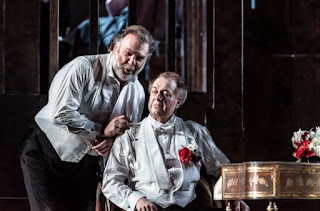 Back in 1999, Catalan stage director Calixto Bieito burst onto the global opera scene with a new production of Bizet’s smash hit, Carmen.
Back in 1999, Catalan stage director Calixto Bieito burst onto the global opera scene with a new production of Bizet’s smash hit, Carmen.It caused controversy, but then again, when the opera was premiered in Paris in March 1875, it scandalised audiences, so why should anyone hope to see it made bland now?
Bizet died after the 33rd performance and, of course, could never know just what a hit it would become. But becoming a staple can dull too, while making it feel raw and alive and throbbing with the threat of violence takes a little more effort.
This production has been staged around the world in the years since, but has just landed at Teatro La Fenice in Venice for a revival season.
Which was most opportune. When The Other Half and I had begun to discuss the serious possibility of revisiting La Serenissima for a spring break, we had looked back at the hotel that we’d stayed in in 2010 – and realised that they organised opera trips.
It was instantly tempting – and not least as a quick look at Le Fenice’s website revealed that, when we were considering being there, Carmen would be playing.
But we didn’t yield straight away, continuing to look at other hotels and, indeed, contemplate booking on our own.
And this we eventually did. We’ve booked for concerts abroad before, in the Amsterdam and Berlin, and it helps that La Fenice has the option to view the site (and book) in English. It also, incidentally, does surtitles in both Italian and English.
For booking, a passport number was required, but that was the only ‘complexity’, other than finding a performance where we could still get two seats together.
But we managed – and for less than it would have cost us to do so as part of a hotel package.
So last Sunday, after a lovely lunch at Taverna La Fenice next door, we passed through the remarkably simple portals and into the legendary house where many of Verdi’s works first played.
After the arsonists’ fire that gutted it in 1996, it was painstakingly recreated, finally reopening in 2004. There were some complaints about the decision to so carefully replicate the previous building, but from my perspective, it looks simply ravishing. Blingly – but ravishing.
 |
| The view from our seats |
And so to the opera, which wasn’t blingy, but has moments of being musically ravishing.
Bieito has updated in such a way as to suggest it’s set sometime from the 1950s to the here and now. The military uniforms, therefore, are simple, rather than fancy.
The sets are pared right back, which allows the piece to speak for itself, while removing most of the spoken dialogue – the reason it’s classed as an opéra comique – means that Bieito has also tightened it. And you lose nothing.
Here we have smugglers smuggling iconic 21st century brands in their cars – consumer goods to brighten the drab lives of the people, just as their hero worship of the glamorous matador Escamillo does.
The silhouette of a vast toro towers over the stage during the third act, bringing to mind themes of masculinity (and, arguably indeed, national identity – very Catalan) and then, as the prelude plays, a single man appears on stage, undresses and performs a stylised dance hinting at matadors and echoing that same theme.
The lighting is soft, so the nudity is not clear, but it certainly drew some sharp intakes of breath (fellow visitors from the UK or, perhaps, the similarly puritanical US?). Personally, I thought it added something to a point in the opera that would, otherwise, simply have been a musical interlude to allow set changes.
The big hits – the Habanera and the Toreador Song – are simply wonderful. The latter in particular was spine tingling, as the chorus strained against a rope strung across the front of the proscenium.
Of the cast, I thought that, while Roberto Aronica sung well as Don José, his acting was a little flat. Veronica Simeoni, on the other hand, is a superb Carmen – great voice and a performance that really had a believable sense of the wild free spirit of the character.
Michëla is a thankless role in some ways, but Ekaterina Bakanova gave her as much guts as possible and sung delightfully, while Vito Pirante was a very enjoyable and deceptively light Escamillo.
But watch out for Simeoni – a young singer who really impresses and seems able to take realism in opera acting to new heights.
The chorus was excellent throughout – as was the house orchestra under the baton of Myung-Whun Chung.
All in all, it would have been difficult to spend a Sunday afternoon in a more thoroughly enjoyable manner.
And the lesson is – don’t buy into organised trips without first seeing if you cannot book for yourself.
• Production photos not from this revival at La Fenice.















